What is the state of global Public Financial Management (PFM)? What reforms should governments prioritize?
These questions were answered at a highly interactive conference in Washington DC. Emphasis was put on interactive table discussions and workshops leading to more lessons learned. Participants shared public finance resilience lessons when facing poly-crises.
Sessions covered the impacts of climate change, crisis management, public investment management, transparency, and digitization. Our presentation and workshop focused on PFM digital readiness.
- PFM Trust Virtuous Circle: Links among revenue mobilization, service delivery, fiscal transparency and accountability
- PFM Efficiency: Use of country systems and Direct Budgetary Support (DBS) for foreign aid
- PFM Effectiveness: Value-for-Money as key concept
- PFM Value-Add: Social, climate and infrastructure investments to achieve government goals
- PFM Transformation: Need for finance ministry modernization with “digital core” for PFM digital transformation

FreeBalance Workshop
1. PFM Trust Virtuous Circle
Public trust seemed to be a sub-theme for almost every ICGFM session this year. Public trust underpins PFM resilience. Work by the (OECD) on public trust was quoted, with many governments experienced reduced trust during the pandemic. Trust relates to legitimacy of government policy.

The consensus expressed during ICGFM sessions:
- Fiscal transparency, including debt transparency, is a precursor for trust with higher citizen trust associated with higher transparency
- Government accountability is fuelled by transparency
- Revenue mobilization benefits from government accountability with higher tax compliance
- revenue administration benefits primarily through integrity: integrity is far more important than technical skills
- Service delivery benefits from increased revenue with improved effectiveness leads to improved tax compliance as citizens witness spending impacts
- Equitable growth through improved service delivery increases social cohesion and trust
FreeBalance Takeaways
- Fiscal transparency, by itself, is rarely viewed as having accountability impact, yet we have seen positive behavioural changes in government when public servants see opaqueness lifted
- Fiscal transparency in aid, budgets and procurement is well-understood and measured thanks to the work by organizations like the Global Initiative on Financial Transparency (GIFT), International Aid Transparency Initiative (IATI), International Budget Partnership (IBP), and the Open Contracting Partnership (OCP)
- Standards for treasury function transparency do not seem to exist, needing work to integrate debt, financial investment, and sovereign wealth transparency given that private sector and Chinese government loans often have confidentiality clauses
- Government accrual accounting improves the accountability of spending effectiveness
- Intensification of conflict: citizen vs state occurs with the lack of equitable spending with vulnerable populations
2. PFM Efficiency
The use of country PFM systems by foreign aid donors enhances effectiveness. “The importance of using country systems when delivering aid lies at the core of the development effectiveness agenda, and for good reason…Bypassing country systems can also weaken a country’s ability to determine its own future by building up and entrenching structures that can undermine the development of country’s own systems. In contrast, using country systems builds ownership, strengthens government institutional capacity, and supports mutual accountability of development resources. (Piatti, Hashim, Alkenbrack, and Gurazada).
One speaker noted that ever dollar counts when saving lives. Panelists emphasized the need to move from the use of public finance country systems, to sectoral systems like health.
The use of country systems was enshrined in the Paris Declaration and Accra Agenda for Action.
Paris Declaration principles (2005):
- Ownership: Developing countries set their own strategies for poverty reduction, improve their institutions and tackle corruption.
- Alignment: Donor countries align behind these objectives and use local systems.
- Harmonisation: Donor countries coordinate, simplify procedures and share information to avoid duplication.
- Results: Developing countries and donors shift focus to development results and results get measured.
- Mutual accountability: Donors and partners are accountable for development results.
Accra Agenda for Action principles (2008):
- Ownership: Countries have more say over their development processes through wider participation in development policy formulation, stronger leadership on aid co-ordination and more use of country systems for aid delivery.
- Inclusive partnerships: All partners – including donors in the OECD Development Assistance Committee and developing countries, as well as other donors, foundations and civil society – participate fully.
- Delivering results: Aid is focused on real and measurable impact on development.
- Capacity development – to build the ability of countries to manage their own future – also lies at the heart of the AAA
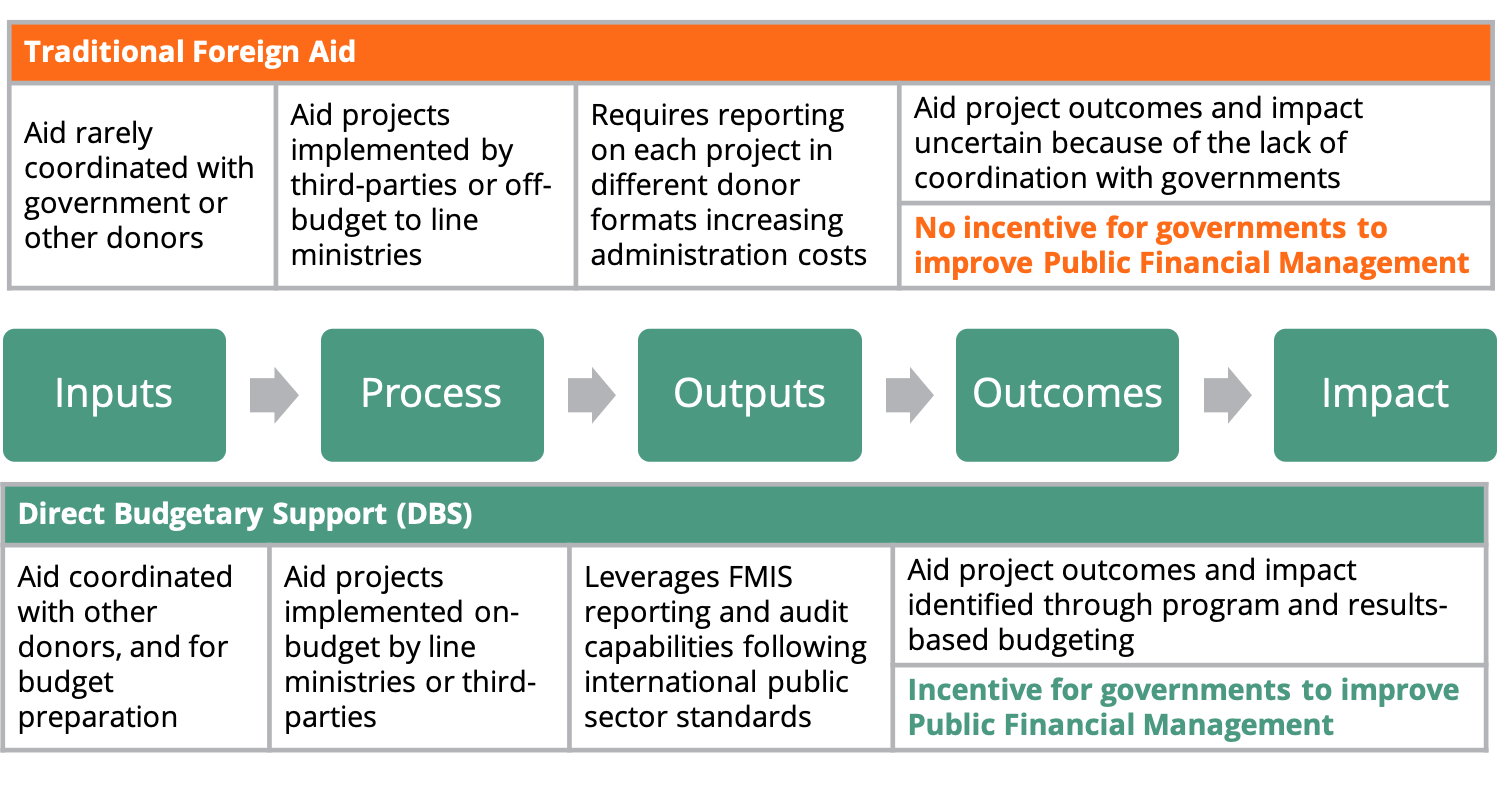
Direct Budgetary Support (DBS) reduces transaction, reporting, and audit costs by aid recipients. For example, up to 40% of United States grants are required for reporting and reconciliation. A 2021 World Bank study found no correlation between country PFM quality, as measured via Public Expenditure and Financial Accountability (PEFA) assessments and use of DBS.
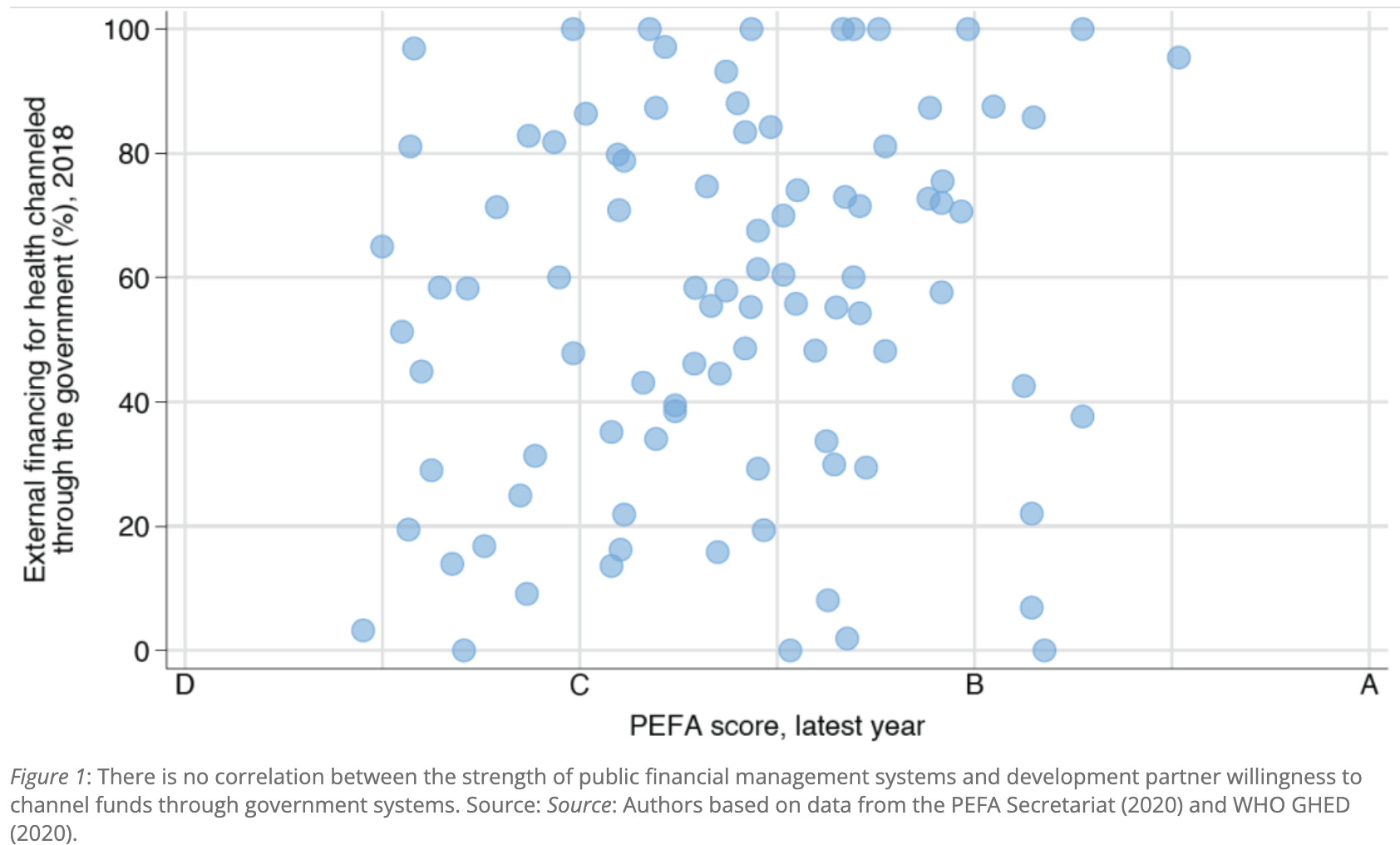
FreeBalance Takeaways
- Reduction of aid transaction costs has become more critical in this polycrises era, with development partners receiving more DBS requests
- PEFA was designed to eliminate multiple donor PFM assessments: it’s high time for donors to leverage these assessments, particularly the 2016 framework
- Emerging Market and Developing Economy (EMDE) countries, including FreeBalance government customers, have demonstrated PFM quality improvements
- Many countries are able to track aid from receipt through entire budget cycles with commitment controls and valid code combinations compliance, through to program results
- Use of country systems improves aid coordination while providing spending and performance audit data
3. PFM Effectiveness
We introduced some additional Value-for-Money (V4M) measurements at the conference. V4M is a strategic concept that applies to complex procurement and the entire performance lifecycle, but ought to be considered for all spending. Governments do not have the profit/loss bottom line enjoyed by businesses to develop performance measures. As a result, public sector performance management is highly complex. V4M matured from 3Es to 5. We’re proposing 8 Es.
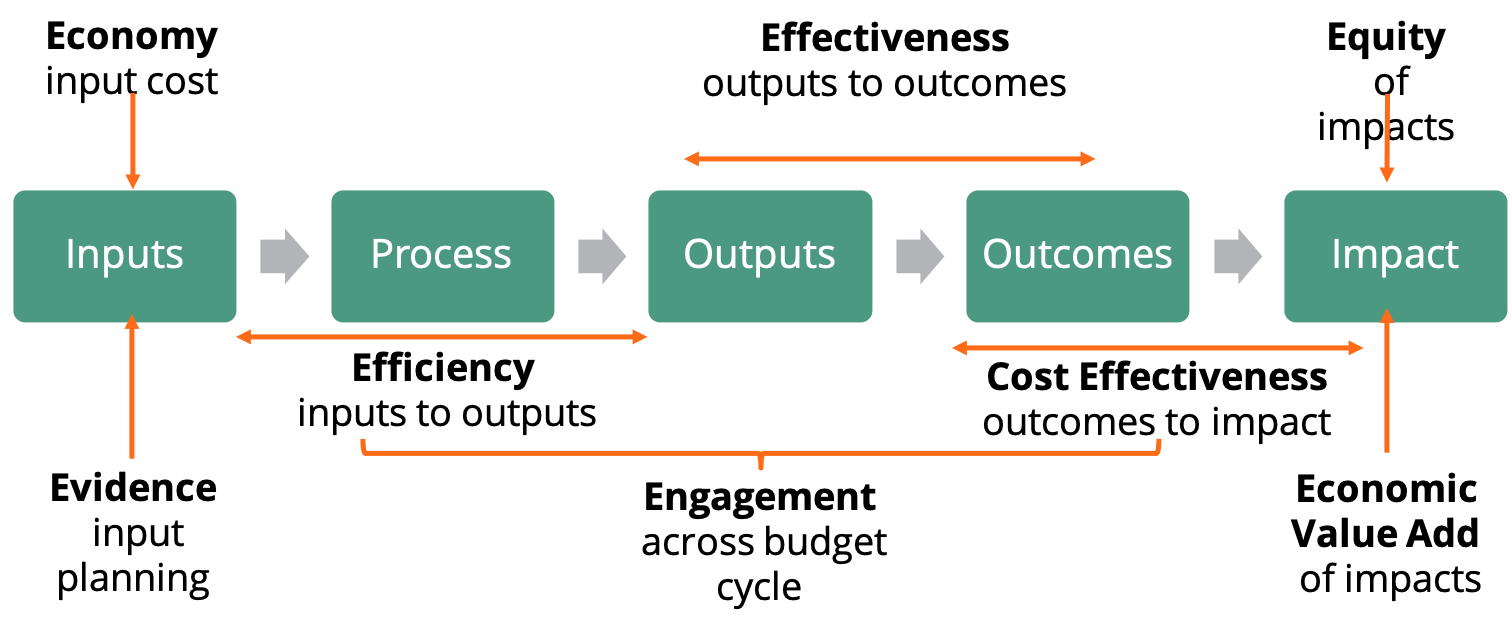
Considering the government health supply chain, V4M concepts include:
- Economy consisting of reduced spend per unit, such as negotiating lower costs for personal protective equipment
- Evidence consisting of health data quality and studies for decision-makers
- Efficiency measuring the productivity of turning costs into outputs, such as the cost to deliver an inoculation
- Engagement consisting of partner, stakeholder, and beneficiary collaboration to improve initial planning followed by optimizing health implementation results
- Effectiveness measuring from outputs to outcomes, such as the cost to reduce a disease by 1%, that is often outcomes from multiple outputs
- Cost Effectiveness to delivery impact, for example, the cost to increase 1 year of life expectancy
- Equity measuring the impact to groups, such as inoculations for marginalized groups
- Economic Value-Add identifies the positive economic impact over time, such as education results, and productive work days improved through health programs
FreeBalance Takeaways
We don’t advocate that 8Es should be used for all government spending. Concepts like EVA requires years to measure. Rather, the 8Es should be considered for key national development plan pillars, especially multiple year social and public investments. Some observations from panels, presentations, and attendee discussions include:
Engagement
- Transparency as precursor to engagement, with accountability as the link between transparency and trust
- Transparency to enable civil society oversight and citizen audit to improve outcomes and enhance corruption identification
- Fiscal transparency to optimize revenue from State-Owned Enterprise while demonstrating whether privatization is necessary
- Fiscal transparency to improve international assessments, PFM credibility, use of country systems
- Debt transparency improves access to capital, credit ratings, private sector investment, especially in the context of private loans and collateralized loans from China with confidentiality clauses
- Stakeholder management improves policy outcomes, process effectiveness, and service delivery
- Communications overcomes concerns and combats disinformation
- Governments are conveners to coordinate business, civil society, and development partner in support of goals
- Internal engagement builds capacity and facilitates change to improve outcomes and improve integrity, including identifying change champions and creating authorizing environments with leadership buy-ibn
Equity
- Pandemic lesson: need to support underserved and most vulnerable
- Service delivery lesson: constraints through lack of connectivity to remote communities
- Non-bias data is also a precursor to using AI effectively and equitably
Evidence
- Data quality for decision-making is often poor, such as tracking over supply chains
- Huge gap in data comprehensiveness, quality, equity, timeliness
- Data quality and availability necessary for research, policy, and improved administrative decisions
- Polycrises lesson: risk management in PFM decisions, and for monitoring and evaluation
- Importance of statistics and forecasting throughout budget cycles, not just planning
- Need for public service data literacy, and use of data standards
- Accrual accounting improves borrowing decisions and reduces arrears
- Use of audit trails important to improve compliance and performance
Economic Value-Add
- Need to balance short and long-term planning, including aligning social and infrastructure investment to meet goals of becoming middle or high income country
- Plan and measure economic benefits of climate adaptation and mitigation investments required
- Identify economic impact of health, education, and infrastructure public investments
Economy
- Privatization and Public-Private Partnerships (PPPs) methods can reduce government costs
- Treasury Single Account (TSA) leverages idle balances, and reduce borrowing needs
- Use of country systems to reduce aid transaction and reporting costs
Efficiency
- Decentralization reduces finance ministry burden for routine tasks
- Automation and use of aggregate controls improves compliance efficiency
- Digital payments improves efficiency
- Customer Experience (CX) methods simplifies complexity and improves service delivery at lower costs
- Pandemic lesson: crisis spending can be accelerated without giving up controls and audit trails
Effectiveness
- Implement V4M regimes for performance management, particularly for evaluating debt effectiveness
- Use of performance audits improves government effectiveness when recommendations followed
- Revenue diversification funds spending priorities when sectors undergoing shocks like commodities and tourism
- Controls and compliance automation helps overcome corruption and mismanagement
- Integrate planning and implementation of capital acquisition budgets with asset management, operations and maintenance budgets for effectiveness
- Public service talent management important to improve effectiveness
Cost Effectiveness
- Issue in many countries when debt repayments exceed health and education spending
- Analysis of increasing borrowing costs to support government spending compared to improving revenue mobilization helps to evaluate cost effectiveness for different revenue source
4. PFM Economic Value-Add

FreeBalance Takeaways
Some observations about linking public finance with EVA:
- Public finance and effective Government Resource Planning (GRP) supports impact enablers
- GRP is software designed exclusively for government, like the FreeBalance Accountability Suite, is designed to support Integrated Financial Management Information System (IFMIS) requirements
- IFMIS portfolios should progressively activate to support PFM reform
- Good governance and digital transformation are precursors, or enablers, of government impact
- PFM and IFMIS provides planning and implementation quality supporting government goals
- PFM may be the most important good governance domain by improving control of corruption, government effectiveness, with voice and accountabiliy representing half of the Worldwide Governance Indicators (WGIs)
- IFMIS implementations may or may not support government digital transformation (see takeaway 5)
- Chart of Accounts (CoA) is the most important form of fiscal metadata to support the digital transformation of PFM
- Social and infrastructure investments are the key PFM contributions to meeting long-term government goals
- Medium-Term Budget Frameworks (MTBF), program budgeting, and Public Investment Management (PIM) practices are effective PFM techniques
- A report, described at ICGFM last year, shows how good PIM results is associated with good PEFA scores
- Investment focus leads to citizen wellbeing and sustainable growth, equivalent to the first 15 Sustainable Development Goals (SDGs)
- SDG 16 relates to good governance, SDG 17 for partnerships
- 12 of the 17 SDGs were negatively impacted by the pandemic
- PFM outcome contributes to prosperity impact

5. PFM Digital Transformation
Our session consisted of a short presentation followed by a workshop. Despite vendor hype, very few PFM digital initiatives are transformational. Most digitize manual processes.
Evidence-based decision-making through the integration of structured, unstructured. and activity stream “big data” represents the promise of PFM digital transformation. Refined data as the new oil.
Institutional reform, and ministry modernization, is a precondition to any major PFM digital transformation journey. More traditional finance ministries need to digitize in smaller steps.
An interoperable PFM digital core is also necessary to support transformation. This goes beyond typical transactional data integration.
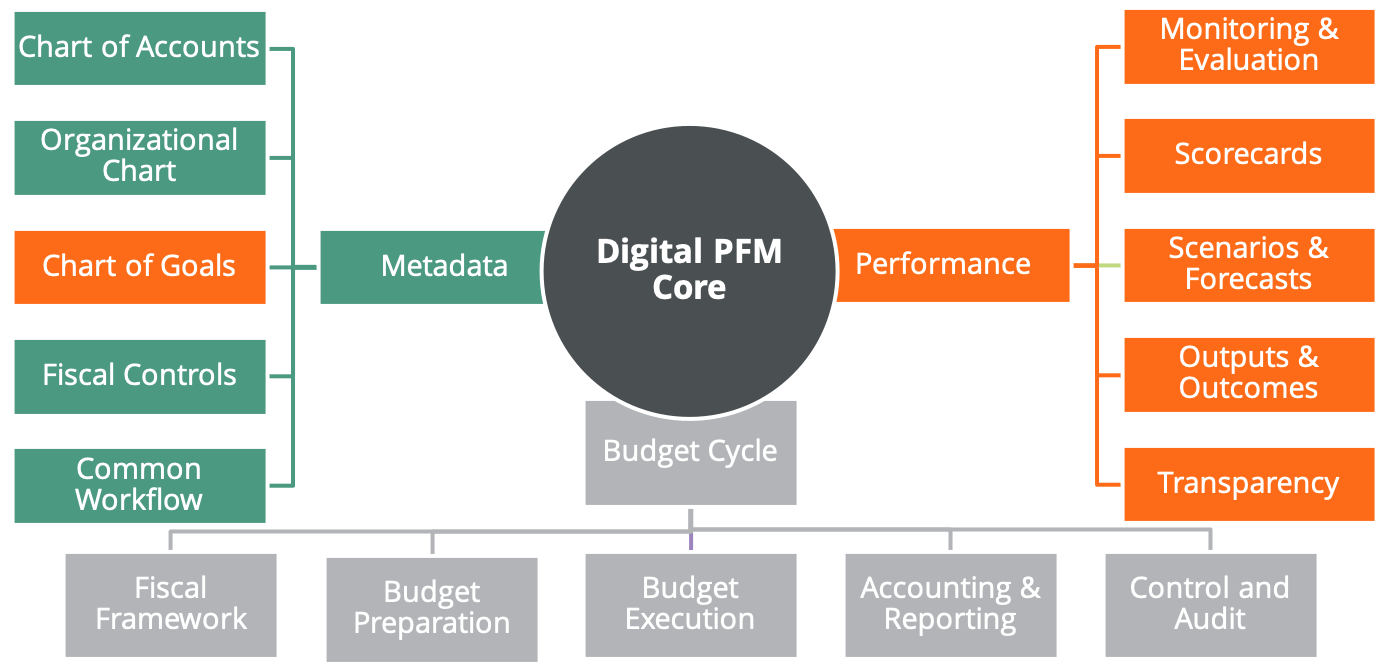
Systems of record, like an FMIS portfolio, need to interoperate to support systems of engagement and systems of intelligence. And, it’s through systems of intelligence that governments become more evidence-driven:
- Metadata integration, such as Charts of Accounts, need to be augmented by consistent fiscal and commitment controls, supporting segregation of duties, to ensure quality data that followed compliant processes
- Performance criteria, such as V4M, needs to integrate with standard metadata, such as typing Charts of Accounts with Charts of Goals
- Budget cycle integration covers every PFM step, such as integrating budget and debt models or aid commitments with budget planning
PFM digital transformation occurs when:
- Government effectiveness improves through performance management and V4M structures whose decision analytics enables evidence-driven decision-making
- Modern accountable finance ministries who decentralize routine fiscal functions supports data literacy and financial management integrated with national development plans
- Budget cycle interoperability: tax administration, treasury, procurement, budget planning, PIM units, and aid units, provides full fiscal insight
- Digital core provides the integrated data for analysis, visualization, forecasting, early warning, risk mitigation, and management alerts
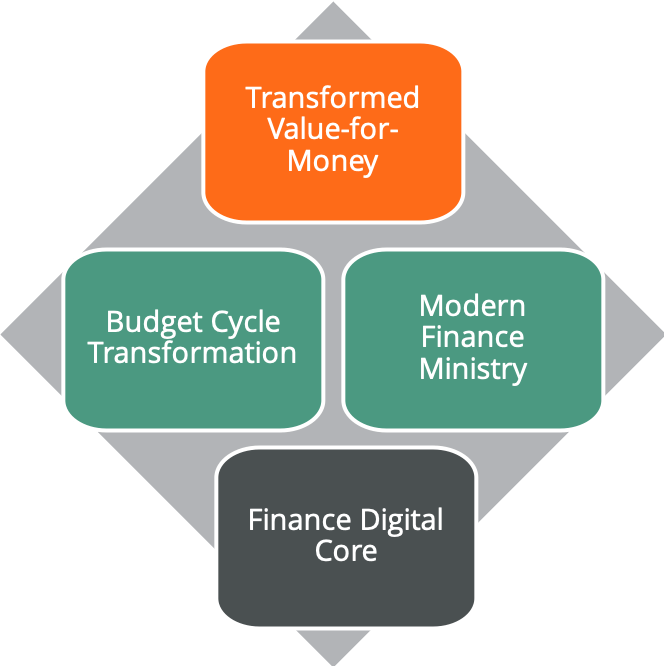
FreeBalance Takeaways
Some interesting observations from panelists and attendees over the course of the conference.
Systems of Record
- It’s as easy to automate problems as solutions
- Most information systems in government were not built to share
Systems of Engagement
- Customer Experience (CX) is very much about data. and equity
- Public participation often seen as nuisance in PFM, yet engagement is valuable
- Transparency can become a dialog between information supply and demand
- Best transparency portals, and citizen budgets are designed via dialog
Systems of Intelligence
- Many public servants are more invested in programs and execution, rather than the data
- Huge gap in using data for policymaking, even in advanced economies
- Artificial Intelligence is focused on future, while traditional PFM tends to report on the past through financial reports
